SEE ALSO "Dusty Winds from Young Star"
SEE ALSO "Modeling dust dynamics "
Planets form out of a dense disk of gas and dust around a newborn star. The physical and chemical conditions inside such disks are of crucial importance for planet formation. Nonetheless, these conditions still remain poorly understood. The limiting factor is increasingly on the part of theoretical interpretation of the accumulating wealth of observational data. The difficulty comes from rather complex analysis of transfer of energy within the disk, where the observable energy emerges only after it has experienced a strong reprocessing by the disk's dust.
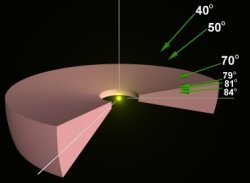
Sketch of a dusty disk around a star. Images of this disk at various
wavelengths and disk inclinations are shown in figures below.
The full theoretical treatment requires rather complex and challenging numerical
tasks that can not be performed on a single-processor machines. Therefore, I developed
a 2D radiative
transfer solver named LELUYA that can go beyond the commonly
used simplifications. It provides the full 2D treatment of energy transfer in
protoplanetary disks, with high resolution self-adaptive grids.
Even more significant step will be possible by merging these calculations with
the dust dynamics, which will increase the computational demands even further.
Especially interesting, and still poorly understood, is the environment within several astronomical units (AU = distance between the Earth and the Sun) of these stars. This region comprises the inner protoplanetary disk where dust evolves from submicron particles to terrestrial planets, bipolar jets are launched, disks accrete onto the star and disk winds form.
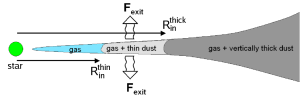
Dust dynamics in protoplanetary disks brings dust closer to the
star than the inner edge of optically thick dusty disk.
This extended inner structure is populated only by big
grains and it is vertically optically thin. Such conditions
enable disk thermal cooling and dust survival.
In the course of my investigation of the inner edge of dusty disks,
I discovered that one important radiative transfer solution has been
overlooked (Vinkovic 2006, ApJ, 651, 906). The sublimation
cutoff of optically thick dusty disks is not a sharp edge, but
rather a relatively large zone that extends almost two times closer
than the optically thick disk edge. In this zone the disk is
vertically thin for the infrared radiation, which allows it to loose
excess heat and, therefore, gets closer to the star.
In reality, the choice of inner edge properties
depends also on the dust dynamics and grain growth.
These two processes, together with dust sublimation, shape the inner region of dusty disks.
Hence, the evolutionary role of such a large
optically thin zone has to be studied further in more detail.
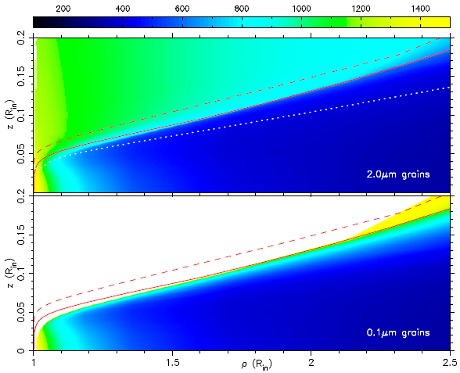
Temperature of dust grains in a disk shown at two spatial scales in cylindrical coordinates for two coexisting grain radii (indicated in
images). Rin is the inner disk radius.
The dashed line indicates the radial optical depth of tau_V=0.1, while the solid line is tau_V=1. Note how 0.1micron grains survive in
the optically thin disc surface only at radial distances larger than 2.2Rin, but in the disc interior they exist very close to Rin.
The dotted line shows the vertical optical depth of tau_V=1.
Vinkovic, D. 2012, MNRAS, 420, 1541 (PDF)
Vinkovic, D., & Jurkic, T. 2007, ApJ, 658, 462 (PDF)
Vinkovic, D. 2006, ApJ, 651, 906 (ADS, PDF)
Vinkovic, D., Ivezic, Z., Jurkic, T., & Elitzur, M. 2006, ApJ, 636, 348 (ADS, PDF)
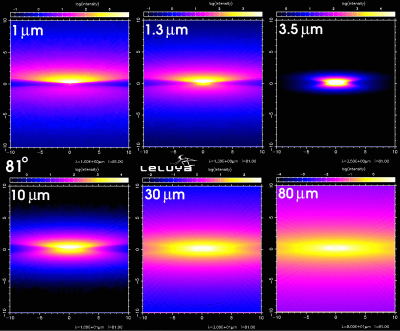
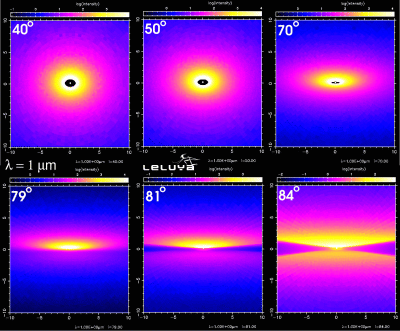
Theoretical disk images are various wavelengths and disk inclination angles.
|